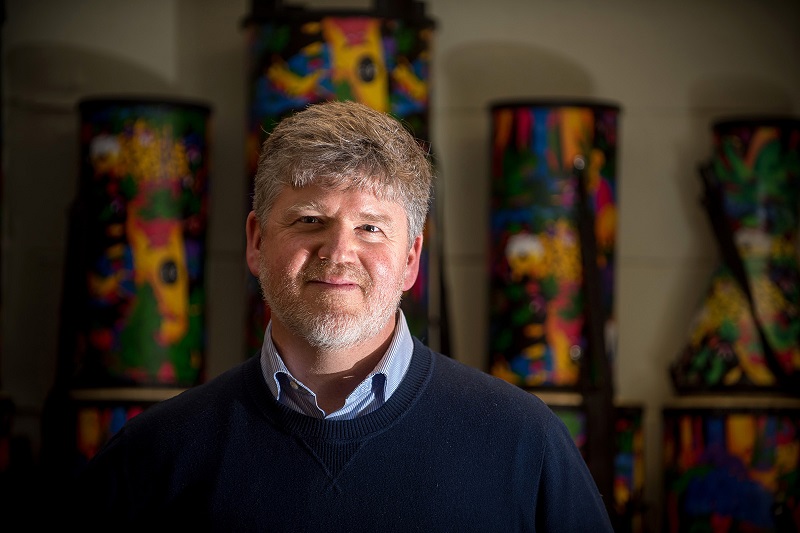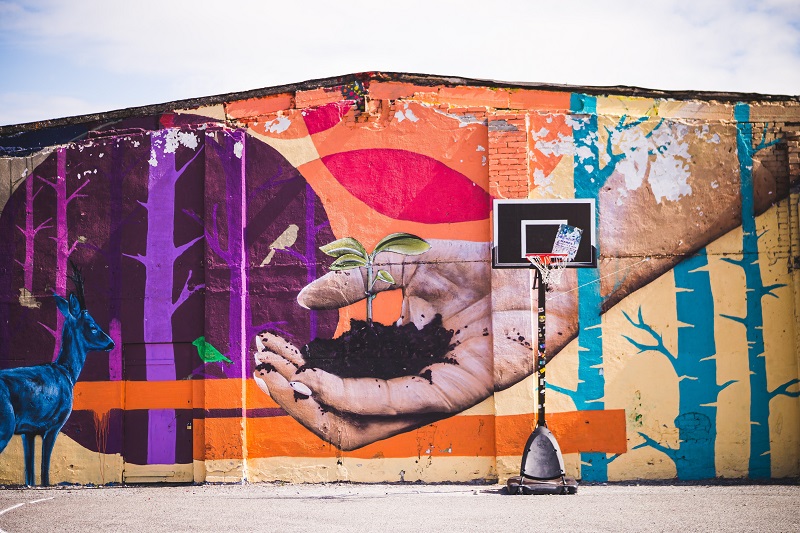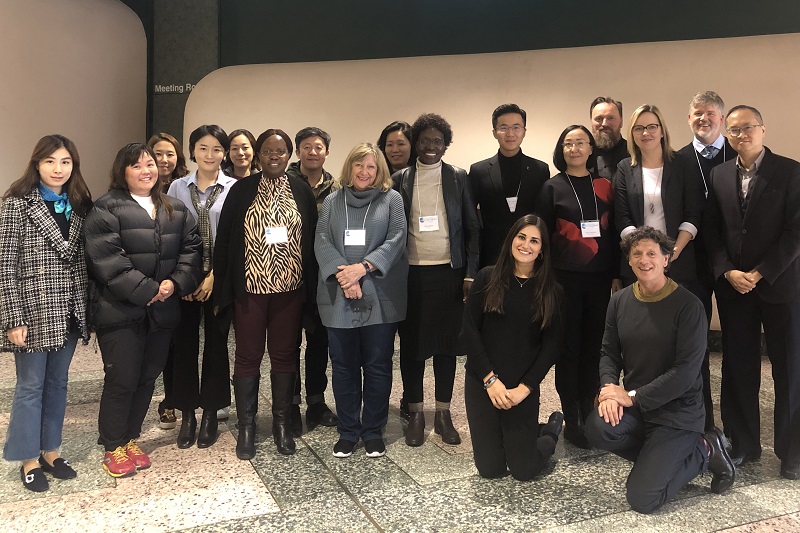
For Ben Bolden, a musician, composer, researcher and associate professor in the Faculty of Education, arts have always helped to transform the world. Bolden is a passionate advocate for arts education and its possibilities for empowering people to address some of the world’s biggest challenges. Now beginning his second term as the UNESCO Chair in Arts and Learning, he leads initiatives that aim to foster arts education – including music, drama, dance, and visual arts – in Canada and internationally.
His efforts align with some of the United Nations Sustainable Development Goals (SDGs), including SDG 4: Quality Education, which seeks to advance inclusive and equitable quality education and promote lifelong learning opportunities for all. Arts education, believes Dr. Bolden, can be a powerful tool to help learners understand themselves and their relationship with the wider world. He recently spoke to the Gazette about his research goals, current projects, and how Queen’s can contribute to improving arts education globally.
Can you tell me about your mandate as the UNESCO Chair in Arts and Learning?
A UNESCO chair is an individual or a team at a higher education or research institution who partners with UNESCO to advance knowledge and practice in an area that is a priority for both the institution and UNESCO. For me, that priority area is arts education. The mandate of the UNESCO Chair in Arts and Learning is to promote access to and quality of arts education through research, communication, and collaboration, in alignment with the UNESCO priorities for education, culture, and sustainable development.
The role is a good fit for me because I’ve had the privilege of benefitting from all kinds of arts education, since I was very young. While this education certainly didn’t make me into a great artist, it did make my life infinitely richer. And when I started teaching in schools I wanted desperately to help others tap into all the wonderful things the arts can offer. But as teachers we are constantly learning, and my goal is to figure out how I, and others, can be effective teachers in and through the arts.
You’re starting a collaboration with the UNESCO associated Schools Network (ASPnet) to develop materials that will support arts education within 11,500 schools worldwide. What are the main goals of this program and what are its main challenges?
UNESCO focuses on what is called transformative education, that is, education that can help students transform themselves and the world they live in. Through transformative education, we educate learners so that they can address real challenges – climate change, sustainability, promoting peace. We are developing a model to communicate and illustrate how teachers can support transformative education with arts learning experiences.
A major challenge is to do something meaningful for people across cultures. We plan to describe specific practices – things that teachers and/or students are doing in different contexts around the world – that will help illustrate what this kind of education can look like.

How can arts education support the achievement of the SDGs beyond addressing access to quality education?
This is very much at the heart of the transformative education model: helping learners better understand what they can do to support the SDGs. Thinking about climate change, for example, arts education might lead to creating a mural that identifies negative effects of climate change, or how people can work locally to minimize its impacts.
That’s an obvious example. But there are also more subtle ones. The real value in arts education is to provide opportunity for learners to better understand themselves and their relationship with the world. The SDGs are all about that relationship, and the importance of nurturing it. Art is a brilliant tool for building understanding. By receiving art – listening to music, experiencing drama and dance, spending time with creative writing and visual artworks – we can gain new perspectives on all sorts of issues, and think about how to negotiate our own interactions with them. Mental health, inequality, peace, justice: What do those things mean to us? To others? How do we position ourselves in relation to them? What can we do? The arts tell the stories that help us find answers.
And arts education is not only about receiving art but also creating it. Let me offer an example. Dance students in Argentina virtually collaborated, during a recent Covid lockdown, to explore and communicate what it meant to them to be confined in bedrooms and apartments, dancing alone. The new relationships that developed with physical surroundings. Dancing in tiny spaces between the wall and the edge of the bed. In making the compilation video the dancers explored what it meant to be confined in this way and how to metaphorically step beyond those confines. By watching the video, I came to understand what that experience was like for those dancers, and I gained new perspective on my own lockdown experiences—the new relationships that I developed with my own physical surroundings, and indeed with myself.
Tell me about the arts education projects Queen’s has been supporting in Nigeria?
We have been working with three NGOs that support education in Nigeria and sub-Saharan Africa: 1 Million Teachers, Five Cowries Arts Education Initiative, and Girl Rising. Together they have established a fantastic teacher education program, online modules that people who are learning to be teachers can access on their cell phones. These is such a need for teachers, and so few resources to help them. I am now supporting the development of a new module on arts education.
This June, Kingston will be hosting an event and exhibition called Muna Taro to build awareness of the work that these three groups have been doing and to increase connections with the Queen’s, St. Lawrence College, and Kingston communities.

You helped set up an international research group focused on arts education, gathering researchers and students from countries like Singapore, New Zealand, Germany, Colombia, Thailand, Kazakhstan, Kenya, and others. What were the lessons you learned from this experience?
We are all researching and advocating for improving arts education around the world. But that looks very different from context to context. We did a global survey of expert art educators, trying to better understand how arts education, its benefits and its challenges are conceptualized and understood in different countries.
One of the lessons I’ve learned is that there are many nuanced aspects to how we understand the arts and indeed education differently. That’s one of the joys I’ve experienced working with this international group —the opportunity to gain new perspectives over and over again.
Recently, I have also been organizing international seminars for graduate students working across the globe, where we become aware of the many approaches to arts education and to arts education research.
You’ve spoken about the role of the chair in advancing arts education worldwide. Are there similar initiatives in Canada?
My chair predecessor, Queen’s professor emeritus Larry O'Farrell, established the Canadian Network for Arts & Learning (CNAL) and I work regularly with this network on a number of initiatives.
One of these is a national campaign to increase awareness about the health benefits of engaging in the arts. Another project, funded by the Canada Council for the Arts, aimed to build digital strategies for arts and learning in Canada. The project connected people within the sector to share and raise awareness about digital tools and resources that can support the work of artists and artist educators.
One such resource, that CNAL created, is an interactive tool to map arts education initiatives across Canada. It’s a central registry for the sector: people who are offering arts education activities can put themselves on the map, and people interested in arts education can look for opportunities. The map has already listed over 9000 organizations and professionals.
Originally published in the Queen's Gazette.